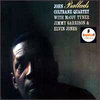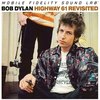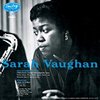SORRY - SOLD OUT
Speakers Corner / Impulse - AS-5 - 180 Gram Virgin Vinyl - AAA 100% Analogue
Limited Edition - Pure Analogue Audiophile Mastering - Pressed at Pallas Germany
Then there are the superb sonics of this remastering – a big improvement over the original LP or CD reissue. All the players are spread out in amazing clarity in front of the listener. The rhythm section comes thru especially clearly, not just a noisy accompaniment to the front line. And of course no surface noise whatever. This is a magnificent tribute to the art of Oliver Nelson. If you have a good turntable system and are a jazz fan you can’t go wrong with this release!
This release from 1961 could easily be entitled 'Blues in modern garb'. Oliver Nelson may perhaps not have been aiming at abstract truth in his compositions, but outstanding solos are certainly found in all six themes – each of them specially composed and arranged by him for this session.
His five low-budget releases for Prestige had caused something of a sensation on the music scene and in particular the participation of the modernist Eric Dolphy gave an amazing boost to the group’s sound. The Impulse production profited from being allotted more time and certainly more money. Thanks to this it was possible to ‘borrow’ Freddie Hubbard and Bill Evans for a short term. And so it was that this milestone in jazz history came about. Teachers in music schools all over the world still present these exemplary cornerstones of jazz music to their pupils in jazz arrangement classes. Nowhere can one better study keys and forms: C minor, rarely heard tonal centres, forms with 44 or 56 bars – these are all things to capture a student’s attention.
For the normal listener, however, the escapades of Eric Dolphy in his solos, the sensitive music-making of the rhythm group, and the audible group sound are of more importance when coming across this rarity in the record store. And whoever hesitates to part with his money when he has this mega-rare so-called ‘photo cover’ in his hands is a hopeless case. Don’t deliberate on buying this album too long. You may have to wait another 40 years before a further re-release comes on the market and there is certainly no guarantee that it will sound as good as this one!
Here from Speakers Corner we have one of the most-beloved
Impulse! releases along with a collection from the label's other
saxophone colossus. It's impossible to peruse the roster of
1961's The Blues and the Abstract Truth and not see a potential
classic. Freddie Hubbard, Bill Evans, Eric Dolphy, Paul
Chambers and Roy Haynes were all headliners and all at the
height of their musical powers. The "Blues" of the title was not
an overt musical theme, but conveyed most prominently through
"Yearnin'." The arrangement and playing on "Stolen Moments"
would prove to be important ingredients in some timeless jazz.
Dolphy's idiosyncrasies are in full bloom on "Teenie's Blues,"
which would have been right at home on his Out to Lunch.
Oliver Nelson was well known as a big-band arranger, but The
Blues and the Abstract Truth would prove that his very best
work was with a sextet, to which he contributed his own playing
on tenor sax.
Aufnahme: Februar 1961 in Rudy Van Gelder Studios, Englewood Cliffs, N.J., USA
von Rudy van Gelder / Produktion: Creed Taylor
Oliver Nelson, alto saxophone, tenor saxophone
George Barrow, baritone saxophone
Paul Chambers, bass
Eric Dolphy, flute, alto saxophone
Bill Evans, piano
Roy Haynes, drums
Freddie Hubbard, trumpet
Selections:
1. Stolen Moments
2. Hoe-Down
3. Cascades
4. Yearnin'
5. Butch And Butch
6. Teenie's Blues Ladies

20 Years pure Analogue
Are your records completely analogue?
Yes! This we guarantee!
As a matter of principle, only analogue masters are used, and the necessary cutting delay is also analogue. All our cutting engineers use only Neumann cutting consoles, and these too are analogue. The only exception is where a recording has been made – either partly or entirely – using digital technology, but we do not have such items in our catalogue at the present time
Are your records cut from the original masters?
In our re-releases it is our aim to faithfully reproduce the original intentions of the musicians and recording engineers which, however, could not be realised at the time due to technical limitations. Faithfulness to the original is our top priority, not the interpretation of the original: there is no such thing as a “Speakers Corner Sound”. Naturally, the best results are obtained when the original master is used. Therefore we always try to locate these and use them for cutting. Should this not be possible, – because the original tape is defective or has disappeared, for example – we do accept a first-generation copy. But this remains an absolute exception for us.
Who cuts the records?
In order to obtain the most faithful reproduction of the original, we have the lacquers cut on the spot, by engineers who, on the whole, have been dealing with such tapes for many years. Some are even cut by the very same engineer who cut the original lacquers of the first release. Over the years the following engineers have been and still are working for us: Tony Hawkins, Willem Makkee, Kevin Gray, Maarten de Boer, Scott Hull, and Ray Staff, to name but a few.
At the beginning of the ‘90s, in the early days of audiophile vinyl re-releases, the reissue policy was fairly straightforward. Companies such as DCC Compact Classics, Mobile Fidelity, Classic Records and others, including of course Speakers Corner, all maintained a mutual, unwritten code of ethics: we would manufacture records sourced only from analogue tapes.
Vinyl’s newfound popularity has led many other companies to jump on the bandwagon in the hope of securing a corner of the market. Very often they are not so ethical and use every imaginable source from which to master: CDs, LPs, digital files and even MP3s.
Even some who do use an analogue tape source employ a digital delay line, a misguided ’80s and ‘90s digital technology that replaces the analogue preview head originally used to “tell” the cutter head in advance what was about to happen musically, so it could adjust the groove “pitch” (the distance between the grooves) to make room for wide dynamic swings and large low frequency excursions. Over time analogue preview heads became more rare and thus expensive.
So while the low bit rate (less resolution than a 16 bit CD) digital delay line is less expensive and easier to use than an analogue “preview head”, its use, ironically, results in lacquers cut from the low bit rate digital signal instead of from the analogue source!
Speakers Corner wishes to make clear that it produces lacquers using only original master tapes and an entirely analogue cutting system. New metal stampers used to press records are produced from that lacquer. The only exceptions are when existing metal parts are superior to new ones that might be cut, which includes our release of “Elvis is Back”, which was cut by Stan Ricker or several titles from our Philips Classics series, where were cut in the 1990s using original master tapes by Willem Makkee at the Emil Berliner Studios. In those cases we used only the original “mother” to produce new stampers.
In addition, we admit to having one digital recording in our catalogue: Alan Parsons’ “Eye in the Sky”, which was recorded digitally but mixed to analogue tape that we used to cut lacquers.
In closing, we want to insure our loyal customers that, with but a few exceptions as noted, our releases are “AAA”— analogue tape, an all analogue cutting system, and newly cut lacquers.















